by Winding Pathways | May 9, 2024 | (Sub)Urban Homesteading, Foraging, Nature
Serendipity
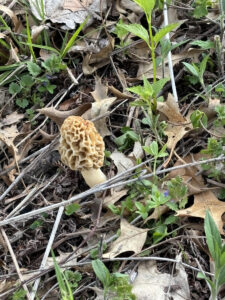
Morels appear like magic.
A surprise morel mushroom sighting was a serendipitous find for Marion. It happened on May Day 2024, in an area of Winding Pathways we’re rewilding. While seeking blooming bluebells and emerging May Apples she spotted the delicious fungus poking through last year’s oak leaves. We’ve since found more. With Cedar Rapids Houby Days just around the corner it looks like a good season for morels.
We own about two acres. Our house, garden, and lawn occupy about half our land. The rest we’re gradually rewilding to its native vegetation. Although we sometimes discover vegetative surprises in our unsprayed lawn, the most delightful new plants appear in our property’s “back 40”.
Nature’s Resiliency
Newly emerging species remind us of nature’s resiliency. A few years ago, a derecho’s 140-mile-an-hour wind knocked down many of our mature trees. Much of our land was shady, but the 40-minute storm transformed it into a sunny landscape. We’ve since noticed a dramatic decline in shade-loving ferns and an increase in sun-loving Wing stem. Other plants are fading and rising as the years go by.
We recently read that archeologists had found 4,000-year-old mullein seeds in an Egyptian tomb. When planted, they sprouted! Lots of native plants may not have the ability to stay viable that long, but they remain down in the soil, perhaps for decades, waiting for the right ecological conditions. Then they rise as if by magic. Other plants can spread their seed widely. Ones that end up in just the right place also sprout seemingly magically.
Pause for Thought
Ecological mysteries give us pause for thought and reasons to marvel at nature’s resiliency. We don’t know if our morels had been in the soil for years or if a spore had landed there more recently. Either way, this spring brought perfect conditions for their growth, and they appeared.
Enjoying Nature’s Abundance
We carefully picked our mushrooms, consulted with an experienced neighbor, and enjoyed them after preparing them and simmering in butter.
We’ll keep watching for others to appear.
Where Do Morels Grow?
Morels live across the country and usually appear in April or May. Hunting them is a popular activity. For information check these websites
Rewilding Winding Pathways
We’re gradually rewilding about an acre of Winding Pathways. Although many believe this simply means “letting nature take its course” we know that’s not feasible today because so many invasive species stress native plants. We manage nature lightly as we rewild our land. Here’s what we do.
- Remove the worst invasive species including Japanese Barberry, Asian Honeysuckle, Multiflora Rose, and Asian Bittersweet. As soon as we spot one, we unleash the lopping shears and chop it off as close to the ground as possible.
- Replaced three areas of lawn with native prairie.
- Carefully use prescribed burns to encourage natives and discourage invasives.
Natural or Native is Not Always Desirable
Two native species belong in our rewilding areas, but we discourage them because of the misery they can cause. We just keep them away from pathways. Here are the culprits:
Poison Ivy: It’s an important and valuable native plant for wildlife. Poison Ivy’s early spring leaves are an almost iridescent red, and they glow bright red in autumn’s fading days. Birds and deer devour the berries. Cottontails love eating the foliage and stems. All good except the itching. Both Marion and Rich are allergic to it and don’t enjoy the awful rashes that result from close encounters. We stay away from poison ivy and don’t cut it but spot-spray those plants growing close to pathways.
Virginia Tickseed: This interesting native doesn’t seem to be used much by wildlife, and it’s rather attractive. Come fall it produces zillions of small burs that are nearly impossible to remove from our clothes. We chop off any we find growing close to paths.
-
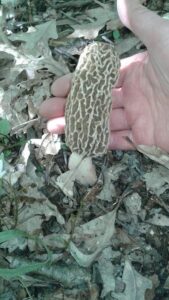
-
Morels’ distinctive shape. Credit Fitzgibbons
-
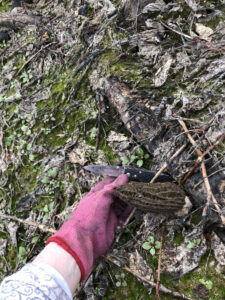
-
Carefully cut or break off a morel. Credit Fitzgibbons
Finding morels was exciting. We’ll likely find plants new to us springing up in our wilder areas. Most won’t be edible like morels, but they are fascinating and are living examples of nature’s resiliency.
by Winding Pathways | Sep 21, 2023 | (Sub)Urban Homesteading, Flowers/Grasses, Foraging, Nature
By September our thoughts and actions turn to autumn – fall sports, raking leaves, and cozy weekend campfires. For wildlife, especially pollinators late summer and early autumn are critical times to gather nourishment for migrations or hunkering down for winter’s scarcity.
-
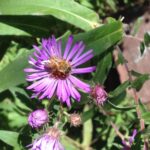
-
Foraging
-
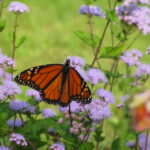
-
Feeding on nectar.
-
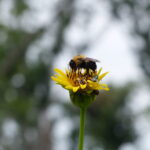
-
Insects find flowers.
-
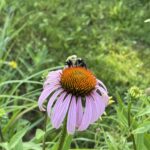
-
Busy at work.
On our daily walks, often in the early morning to avoid late-season heat, we notice and appreciate late bloomers and nut abundance. Nectar is an important food supply for pollinators who busily forage among flowers. When the weather cools, pollinators are out later in the day as the sun warms the air. Remember, there is a “night shift” of pollinators, too, who need flowers to feed from.
Here are some late-blooming flowers we have seen on walks or that we nurture in our yard.
-
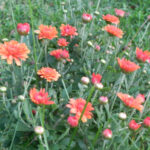
-
cultivated flowers work, too.
-
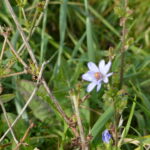
-
Roadside blooms are important.
-
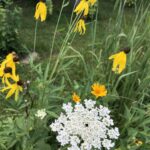
-
Color contrast.
-
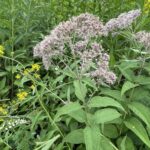
-
Some flowers prefer low lying areas to grow.
by Winding Pathways | Jun 22, 2023 | (Sub)Urban Homesteading, Foraging, Mammals, Nature, Pests
Fish Camp Woes
This year a giant bear tore up the Popsie Fish Company’s camp near the remote Egegik River in Southwest Alaska before the salmon arrived. These huge brown bears are smart, hungry, and massively powerful.
Early Work on Salmon
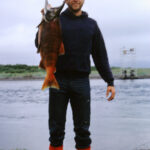
Good Catch
Early in his career, Rich was a salmon biologist for the Alaska Department of Fish and Game, working near the Egegik River. While there he loved eating the most delicious fish……. Sockeye Salmon.
During the summer millions of wild salmon of five species swarm into Bristol Bay but the sockeye is the most abundant. They are caught by many commercial fishing companies who net them in the bay and along beaches. State biologists ensure that enough fish survive nets to ascend rivers, spawn, and produce plenty of young to keep the runs robust.
Remembering Salmon Dinners

Fresh salmon is a treat.
Nearly a half-century ago he and Marion, co-owners of Winding Pathways, moved to the Midwest where there are no Sockeye Salmon. But they love grilling salmon fillets they order from the Popsie Fish Company. It catches, processes, and ships frozen fillets. The Pattersons occasionally order a box. In addition to being delicious and healthy, Alaskan Sockeye salmon are wild fish managed as a sustainable resource.
Bears on the Prowl
This year Popsie Owner Tony Neal had a problem. Like all commercial fishermen, he and his staff arrived well before the salmon run to set up their camp and prepare for fishing. That’s when the trouble arrived.
A brown bear tore its way into their building. Take a look at the photos to see what the bear did. It’s a mess.
-
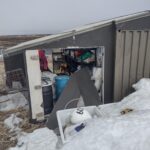
-
Bears are powerful. Photo Eric Handstad
-
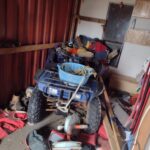
-
The work room is all shambles after a bear tore it up. Photo Eric Handstad
There is good news. There’s enough time before the salmon arrive to get everything fixed and ready to catch those delicious fish. To see Popsie Fish Company staff in action take a look at their website www.popsiefishco.com.
Increasing Occurrences of Bears
Iowans occasionally report a bear sighting, especially in NE Iowa where the woods make great shelter and rivers excellent corridors to travel.
Bears are increasing across the country even in urban areas. Past photos in papers have shown a bear walking down a major road near New York City. A recent newspaper article reported how a bear crashed into an Avon, CT, bakery and gobbled up 60 cupcakes before lumbering off. At Cedar Lake, Denville, NJ, a mama bear, and three cubs were recently spotted walking along the road. Actually, that is a fairly common sighting. Residents spread the word so walkers will be alert.
-

-
Suburban NJ has some prolific and big bears.
-
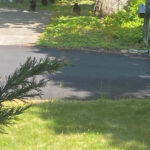
-
Bear and cubs. Photo Catherine Christ
The town police even fondly named one bruin “The Italian Bear.” Each night just after restaurants closed a fat bear would wander from its den, climb into the local Italian eatery’s dumpster, gorge itself, take a snooze, and come morning, climb out and go back to its secret den. Never hurt anyone.
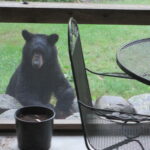
SRF took this pix of a bear peering in the window.
In rural New Hampshire, friends have had bears visit the yard and peek into the house through the windows frequently.
First Person Story

Picket fence was torn apart by a hungry spring-time bear.
Jackie and Peter Hull in Bedford, Virginia, shared this first-person story of the spring adventures with an unruly bear. “Well, I got up bright and early one spring morning, peeked out the bedroom window and what did I see? A smashed six-foot piece of picket fence, a broken spindle on the front porch, and a shepherd’s hook bent to the ground.
“Lucky me I brought the bird feeders in last night. So now I know I can’t feed the birds anymore this year. This is the second year running when on Mother’s Day last year, a bear came and smashed the spindles on the porch railing and a different six-foot piece of fence.
“Later we found bear tracks in the red Virginia clay bordering the flower bed on the outside of the fence. It left its muddy red prints on the fence and the steps going to the side door of the house!
“What to do but repair the fence again, wash the feeders, and put them in the basement? I have decided to store the leftover bird feed in a large bag in the freezer for next winter.
“I will miss my “bird buddies” but I don’t what a 250+ pound bear in my house either. So, words to the wise, the same ones the ranger gave me last year, ‘Bring your feeders in now.'”
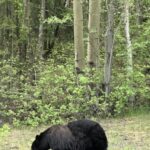
Alaskan Bear.
Back in Alaska, it is common even in suburban Anchorage neighborhoods to see a bear lumbering down a road. An Alaska-born, former Gazette editor spoke nonchalantly about bears and recess at schools. “We always had outdoor recess…except when a bear roamed the playground.”
Bears are about that is for sure!
by Winding Pathways | May 25, 2023 | Foraging, Nature
The Guys Do the Work
Some aspects of sunfish sex are bizarre. Here is a huge family of many species of fish where the guys do the hard work caring for their babies. That’s unusual in the animal kingdom, where normally mom cares for the young.
There are many sunfish species. Most are native to the eastern United States but they’ve been stocked all over the world. Bluegills, pumpkinseeds green sunfish, and crappies are abundant, easy to catch, and tasty. That’s why they’re called “panfish.” Largemouth and smallmouth bass also belong to the Centrarchidae, or sunfish, family but most people consider them gamefish.
How It Works
As water warms in the spring, the males of most sunfish species create a round depression in the sand in shallow areas of a lake or pond. Females don’t help a bit with nest building and spend their days cruising the water seeking tasty invertebrates to eat. They visit a nest only to lay eggs, which are immediately fertilized by the tending male. She leaves. He stays. Lots of pesky small fish love eating sunfish eggs, so the poor male spends his days chasing them off. Finally, after the eggs hatch and babies leave the nest, he’s free to join the females roaming the pond.
Many sunfish species nest throughout the warm months, while others, like bass and crappies, have one spawning season. One part of sunfish sex is absolutely strange.
Unusual Area
A four-acre pond where Rich fishes has relatively deep water and only one shallow area suitable for sunfish to nest. It is small so round nests are crowded together, forcing the two sunfish species to spawn near each other.
Green Sunfish are smallish but aggressive colorful fish with relatively large mouths. They usually dwell in rocky areas. Bluegills are one of the largest of the sunfish. When both nest in close proximity hybrids result. They look a little different from each parent species. The strange part is that nearly all the hybrids are males!
Sunfish are amazingly common, fascinating, and often colorful. Males are fun to watch as they patrol their circular nests driving off intruders.
-
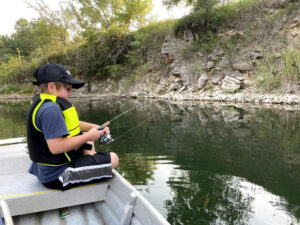
-
Sunfish are fun to catch.
-
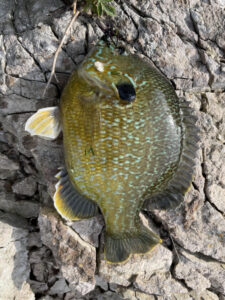
-
Chunky hybrid sunfish.
by Winding Pathways | Mar 9, 2023 | Foraging, Geology/Weather, Maple Syruping
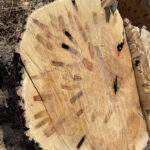
A slice of history.
Scars in a tree at the Indian Creek Nature Center reveal maple syruping history.
Back in 1979 Rich Patterson and volunteers approached a husky Box Elder tree, armed with a drill, spile, and buckets. It was early March. Nights were cold and frosty, followed by warm sunny days. Syrupin’ weather.
Oozing Out the Sap
As soon as the drill’s bit cut through the tree’s bark, clear watery sap oozed out.
Rich gently tapped in a metal spile and hung a bucket under it. By day’s end, two gallons of clear sap nearly filled the pail ready to be boiled into syrup.
-
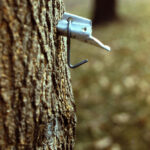
-
The spile angles slightly downward.
-
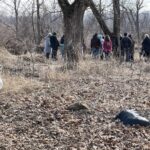
-
Visitors and plastic bag on tree
If not overdone tapping just harvests a small percentage of a tree’s sap. It’s sort of like a person giving blood. Taking a little does no harm. Healthy trees quickly create a scab over the tap hole, somewhat like a human body heals a scratch. As the tree grows and its trunk diameter swells, wood forms over the old tap hole. It’s fine to tap that tree again next year, the year after, and every following year.
Syruping season ends when night temperatures don’t drop below freezing. That’s when spiles are pulled, leaving the hole for the tree to heal.
Aging Out of Production
That’s what happened to the Nature Center’s tree. Box Elders are true maples capable of producing sap for quality syrup, but they are short-lived. An 80-year-old Box Elder is, well, elder and near life’s end. After being tapped for 40 years in a row the Nature Center’s box elder reached the end of its days converting solar energy into sugar. After its death staff felled it, revealing at least 30 tap scars. The oldest ones are closest to the center of the tree’s trunk.
Syruping is a fun late winter activity. To learn more visit the Indian Creek Nature Center during syruping season. It holds a fun Maple Syrup Festival in late March each year. For details check out Indian Creek Nature Center’s website.
Thanks, box elder for sharing some of your sap all these years.
-
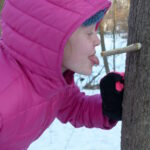
-
Tasting sap from a sumac spile
-
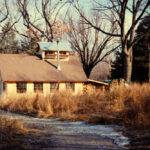
-
Syrupin’ time is upon us!
by Winding Pathways | Feb 2, 2023 | Foraging, Nature, Pests, Trees, Trees/Shrubs
Disappearing Ash Trees
Ash trees are fast disappearing from American forests and towns. It’s tragic.
There are several ash species, including white, green, blue, and black. A Chinese native insect, the Emerald Ash Borer, is killing them all quickly. It’s awful.
Years ago, Dutch Elm Disease cleared cities of American elms, and many homeowners and towns planted green and white ash trees to replace them. Ashes, in general, thrive in the woods and towns. They grow relatively quickly, resist storm damage, and are beautiful. They seemed like an ideal urban tree.
That was true until Emerald Ash Borers were found in Michigan in 2002, although they may have been around at least a decade earlier. Since then, the insect has spread like crazy, killing ashes radiating outward from Michigan.
They reached Iowa years later and have since killed most of the trees in Cedar Rapids, area woodlands, and many other towns.
Salvaging Ash trees
Rich salvages wood from a scrap pile of used pallets. Pallets are made from cheap wood, like cottonwood, poplar, and hackberry, but now he’s finding ones made of ash.
Loggers are salvaging dead and dying ash trees, and the wood is cheap, at least for now. Soon ash lumber will no longer exist.
A Versatile Wood
Sports fans will miss ash wood. It makes the best baseball bats and has been used for gymnastic bars.
Ash also is crafted into gorgeous furniture.
We lost our big ash tree in the August 2020 derecho, but it was already infested with borers with its days numbered. Sadly, we cut the tree up but gave it a second task. It harvested solar energy and used it to make wood. That wood is now being fed, piece by piece, into our woodstove. It’s keeping our home warm, but we’d rather have our tree.
-
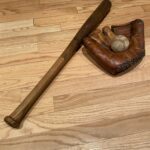
-
Ash bat on oak floor.
-
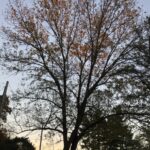
-
The ash tree anchored our east corner of the property.
-

-
White Ash bats will soon be a memory as these elegant trees die.






























